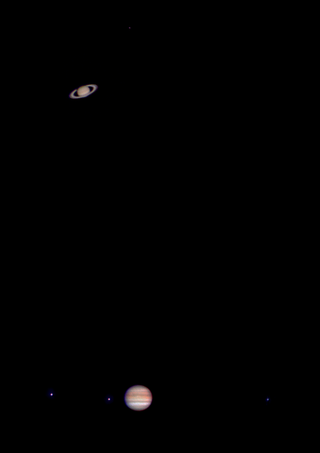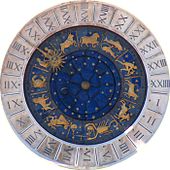
The zodiac is a belt-shaped region of the sky that extends approximately 8° north and south of the ecliptic, which is the apparent path of the Sun across the celestial sphere over the course of the year. The orbital paths of the Moon and major planets are within the belt of the zodiac.

A horoscope is an astrological chart or diagram representing the positions of the Sun, Moon, planets, astrological aspects and sensitive angles at the time of an event, such as the moment of a person's birth. The word horoscope is derived from the Greek words ōra and scopos meaning "time" and "observer". It is claimed by proponents of astrology that a horoscope can be used as a method of divination regarding events relating to the point in time it represents, and it forms the basis of the horoscopic traditions of astrology, although practices surrounding astrology have been recognized as pseudoscientific since the 18th century. Horoscope columns are often featured in print and online newspapers.

Western astrology is the system of astrology most popular in Western countries. Western astrology is historically based on Ptolemy's Tetrabiblos, which in turn was a continuation of Hellenistic and ultimately Babylonian traditions.

In Astrology, an aspect is an angle that planets make to each other in the Horoscope; as well as to the Ascendant, Midheaven, Descendant, Lower Midheaven, and other points of astrological interest. As viewed from Earth, aspects are measured by the angular distance in degrees and minutes of ecliptic longitude between two points. According to astrological tradition, they indicate the timing of transitions and developmental changes in the lives of people and affairs relative to the Earth.

Hindu astrology, also called Indian astrology, or Jyotisha ; from jyót “light, heavenly body", and more recently Vedic astrology, is the traditional Hindu system of astrology. It is one of the six auxiliary disciplines in Hinduism that is connected with the study of the Vedas.

In Ancient Greek philosophy and astrology, the climacterics were certain purportedly critical years in a person's life, marking turning points.

A great conjunction is a conjunction of the planets Jupiter and Saturn, when the two planets appear closest together in the sky. Great conjunctions occur approximately every 20 years when Jupiter "overtakes" Saturn in its orbit. They are named "great" for being by far the rarest of the conjunctions between naked-eye planets.

Mundane astrology, also known as political astrology, is the branch of astrology dealing with politics, the government, and the laws governing a particular nation, state, or city. The name derives name from the Latin term mundus, 'world'.

Natal astrology, also known as genethliac astrology or genethlialogy, is a system of astrology that claims to shed light on an individual’s personality or path in life based on constructing a horoscope or natal chart that includes the exact date, time, and location of an individual's birth. Natal astrology is found in the Indian, Chinese, Hellenistic and Western astrological traditions.

In astrology, exaltation is one of the five essential dignities of a planet. The exaltation is a place of awareness for the planet, whereas the fall is a position of weakness concerning the function of the planet. The sign position directly opposite a planet's sign of exaltation is considered to be its fall.

In astrology, a planet's domicile is the zodiacal sign over which it has rulership. This is a separate concept from the houses of the horoscope. A planetary ruler is given to each sign, over which the planet is said to have a more powerful influence when positioned therein. The ruling planet associated with a sign is also used as an implied focus of interpretation for the signs on house cusps in a chart. A planet is considered to be in domal dignity when it is positioned in the sign it rules. This is the strongest of the five essential dignities of a planet. Domicile is an archaic term in infrequent, specialist uses today; most astrologers use the simpler term "sign".

Ketu is the descending lunar node in Vedic, or Hindu astrology. Personified as a deity, Rahu and Ketu are considered to be the two halves of the immortal asura (demon) Svarbhanu, who was beheaded by the god Vishnu.

Astrological transits are one of the main means used in horoscopic astrology to forecast future trends and developments. As its name implies, astrological transits involve a method of interpreting the ongoing movement of the planets as they transit the horoscope. This is most often done for the birth or Natal Chart of a particular individual. Particular attention is paid to changes of sign, or house, and to the aspects or angles the transiting planets make with the natal chart.
Sade-Sati is the 7+1⁄2 years long period of Shani (Saturn). This astrological phase is much feared by those in India who believe Indian astrology. This is a period with many challenges, but also a time of great achievements and recognition.
Dasha The dasha pattern shows which planets according to Hindu astrology would be ruling at particular times.

In astrology, planets have a meaning different from the astronomical understanding of what a planet is. Before the age of telescopes, the night sky was thought to consist of two similar components: fixed stars, which remained motionless in relation to each other, and moving objects/"wandering stars", which moved relative to the fixed stars over the course of the year(s).

Balarishta in Hindu astrology is one of the Arishtas. These Arishtas are indicated by certain specific planetary situations or combinations or associations present at the time of one's birth or at the time of query or at a particular muhurta or happening as are revealed by the Natal Chart or the Query Chart or the Muhurta Chart. It is a Dosha.

In Hindu astrology, Vakri grahas are those planets of the Solar System other than the Sun and the Moon that appear to move backwards, which apparent motion is due to Earth’s orbit. Vakri in Sanskrit means twisted or crooked; it also means indirect, evasive and ambiguous. A Vakri graha is also known as the Saktha graha. Vakragati confers exceptional i.e. Cheshtabala, to Vakra grahas whose strong influence is expressed by the manner they affect the Natal Chart and by their transits. The two Lunar Nodes have perpetual retrograde motion.

Maraka in Hindu astrology refers to the planet or planets that cause death at the end of a particular life-span; if the assessed life-span is not over they cause accident, ill-health, poverty and misery during the course of their dasha or antra-dasha or in the period of the planet associating/influenced by them. Each lagna has a fixed maraka or marakas. The two luminaries, the Sun and the Moon, and the lord of the 9th house generally do not become marakas. The lords of the 2nd and the 7th house, or the malefic planets occupying anyone of these named houses and associated with their lords are the Primary determinants of death. The Secondary determinants of death are the benefic planets in association with lords of 2nd and 7th house or the lords of the 3rd and 8th house, or the lord of the 3rd or the 8th associating with the lord of the 2nd or the 7th house. The Tertiary determinants of death are Saturn associating with any of the afore stated marakas, the lord of the 6th or the 8th associated with a maraka, and the least powerful planet in the horoscope. The transit influences of the Sun, Mars and Jupiter are taken into account for determining the time of death.








